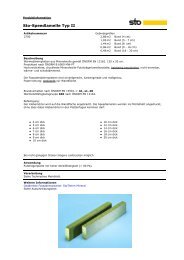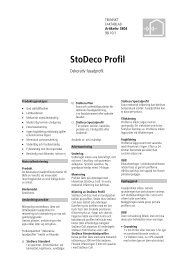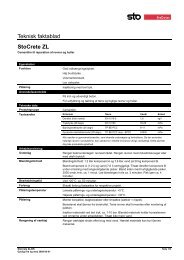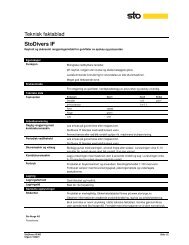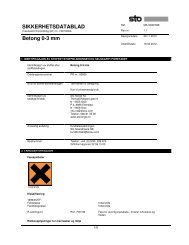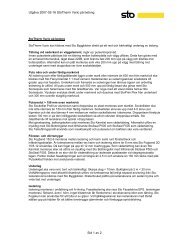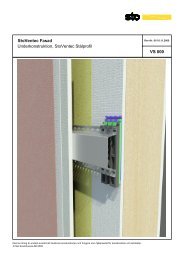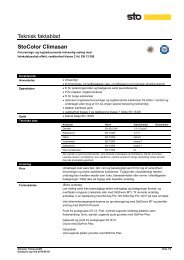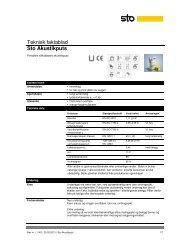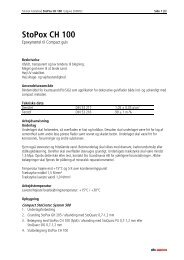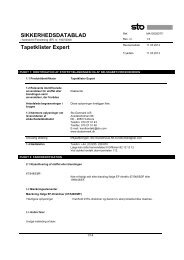International (english) - Sto
International (english) - Sto
International (english) - Sto
Create successful ePaper yourself
Turn your PDF publications into a flip-book with our unique Google optimized e-Paper software.
| Facade | Decorative surface design | Effect and textured coatings |<br />
Patina 1<br />
Application of the surface<br />
<strong>Sto</strong>lit Milano spotting technique, two-coloured – a surface inspiration from the Designer Collection 2012/13<br />
The international team of <strong>Sto</strong>Designers meets every two years to<br />
determine the surfaces, textures and colours that have a future.<br />
The current “Designer Collection 12/13“ comprises ten studies of<br />
surfaces for wall designs which are far from conventional.<br />
The surfaces and textures created are the result of the combination<br />
of high-quality products and expert craftsmanship and skills<br />
as opposed to the result of finished industrial products. Therefore,<br />
the surface studies are to be seen as unique rather than<br />
standardised surfaces. This fact must be taken into account when<br />
adapting these surfaces for actual projects, as well as the fact<br />
that a project- and not only the product-related degree of planning<br />
and practice beforehand are absolutely essential! It is the<br />
creation of an adequately dimensioned sample area on the actual<br />
object by the applicator that reflects what can be built on in<br />
relation to the project. A sample board does not achieve this level<br />
of bindingness!<br />
In the practical reproduction of the surface studies, we also<br />
request you to observe the following: The substrates must be<br />
tested for suitability prior to the application of the product and<br />
pretreated in accordance with the Technical Data Sheets. Furthermore,<br />
the limitations with regard to the size of the surface area,<br />
colour selection etc. must be taken into consideration.<br />
Minor deviations in relation to products or designations are<br />
possible according to the region/country. Therefore, please<br />
contact your <strong>Sto</strong> partner before planning a surface from the<br />
DC Collection!
Top coat<br />
Info<br />
A colour-matched, adhesion-promoting coat of <strong>Sto</strong>-Primer is<br />
recommended for mineral substrates.<br />
Organic substrates can be directly worked on. However, it makes sense<br />
to adjust the colour. A reinforcement layer of at least 3.5 mm is<br />
prescribed on external wall insulation systems and ventilated<br />
rainscreen-cladding systems. A particular evenness of the surface is a<br />
prerequisite, if necessary, levelling filler coatings should be planned<br />
here.<br />
3b<br />
Using a moist <strong>Sto</strong>-Latex Sponge<br />
(08241-002) float-finish the layer at once<br />
until it is pore-free, applying light<br />
pressure. (Slightly moisten the <strong>Sto</strong>-Latex<br />
Sponge using a water spray bottle).<br />
Leave the coating to dry.<br />
Unless described otherwise, the regulations of the<br />
relevant Technical Data Sheet are applicable for<br />
<strong>Sto</strong>lit Milano.<br />
1<br />
Apply one or more coats of <strong>Sto</strong>lit Milano<br />
in the required colour shade as a priming<br />
or equalisation levelling coat with the<br />
stainless steel <strong>Sto</strong>-Smoothing Trowel<br />
(08288-030).<br />
4<br />
Apply <strong>Sto</strong>lit Milano in a second colour<br />
shade as an open, coarsely spotted<br />
coating. The material is applied to the<br />
surface and smoothed into a smudge<br />
with the stainless steel <strong>Sto</strong>-Smoothing<br />
Trowel (08288-030) held flat. Layer<br />
thickness of the spotted coating approx.<br />
1 – 1.5 mm.<br />
2<br />
If spatula burrs/ trowel grooves are visible<br />
after drying, plane these. Then remove<br />
any dust from the surface.<br />
5<br />
The individual spotted filler layers and/or<br />
their transitions are smoothened to be<br />
pore-free using a slightly moistened (not<br />
wet) <strong>Sto</strong>-Latex Sponge (08241-002).<br />
Then leave to dry! The final spotting<br />
effect mainly depends on the selected<br />
<strong>Sto</strong>lit Milano colour tone. Repeat the<br />
application step if required.<br />
3a<br />
Apply <strong>Sto</strong>lit Milano in the same colour<br />
shade as a thin-layer intermediate filler<br />
coat with the stainless steel<br />
<strong>Sto</strong>-Smoothing Trowel (08288-030).<br />
Colour shade/L*:<br />
The lightness value should not fall below 15 as the <strong>Sto</strong>lit Milano<br />
finishing render would otherwise have a stronger tendency to<br />
chalking with visible lightening of the colour shade.<br />
Size of the surface area:<br />
No limitations<br />
Miscellaneous:<br />
Prior to application, a sample/ reference surface should always<br />
be created in the size adapted to the project.<br />
Not suitable for all EWI systems.<br />
The use within the system must be verified both with regard to<br />
national regulations and in relation to the project.<br />
Head office<br />
<strong>Sto</strong> AG<br />
Ehrenbachstraße 1<br />
79780 Stühlingen<br />
Gemany<br />
Phone +49 7744 57-0<br />
Fax +49 7744 57-2178<br />
infoservice@stoeu.com<br />
www.sto.com<br />
The concrete technical specifications and information on the<br />
products contained in the Technical Data Sheets and approvals<br />
must be observed.
| Facade | Decorative surface design | Effect and textured coatings |<br />
Patina 2<br />
Application of the surface<br />
<strong>Sto</strong>Color Metallic on <strong>Sto</strong>Armat Classic AS – a surface inspiration from the Designer Collection 2012/13<br />
The international team of <strong>Sto</strong>Designers meets every two years to<br />
determine the surfaces, textures and colours that have a future.<br />
The current “Designer Collection 12/13“ comprises ten studies of<br />
surfaces for wall designs which are far from conventional.<br />
The surfaces and textures created are the result of the combination<br />
of high-quality products and expert craftsmanship and skills<br />
as opposed to the result of finished industrial products. Therefore,<br />
the surface studies are to be seen as unique rather than<br />
standardised surfaces. This fact must be taken into account when<br />
adapting these surfaces for actual projects, as well as the fact<br />
that a project- and not only the product-related degree of planning<br />
and practice beforehand are absolutely essential! It is the<br />
creation of an adequately dimensioned sample area on the actual<br />
object by the applicator that reflects what can be built on in<br />
relation to the project. A sample board does not achieve this level<br />
of bindingness!<br />
In the practical reproduction of the surface studies, we also<br />
request you to observe the following: The substrates must be<br />
tested for suitability prior to the application of the product and<br />
pretreated in accordance with the Technical Data Sheets. Furthermore,<br />
the limitations with regard to the size of the surface area,<br />
colour selection etc. must be taken into consideration.<br />
Minor deviations in relation to products or designations are<br />
possible according to the region/country. Therefore, please<br />
contact your <strong>Sto</strong> partner before planning a surface from the<br />
DC Collection!
Top coat<br />
Info<br />
A colour-matched, adhesion-promoting coat of <strong>Sto</strong>-Primer is<br />
recommended for mineral base coats. Organic substrates can be<br />
directly worked on.<br />
3a<br />
Apply <strong>Sto</strong>Armat Classic AS with the<br />
rust-free 4 x 4 mm <strong>Sto</strong>-Adjustable<br />
Toothed Trowel (08255-001) and the<br />
<strong>Sto</strong>-Toothed Blade tooth shape<br />
C1 (08373-004).<br />
Unless described otherwise, the regulations of the<br />
relevant Technical Data Sheet are applicable for the<br />
products used.<br />
1<br />
Apply <strong>Sto</strong>Armat Classic AS in the required<br />
basic colour shade as a priming or equalisation<br />
levelling coat with the stainless<br />
steel <strong>Sto</strong>-Smoothing Trowel (08288-030).<br />
3b<br />
Smooth with the <strong>Sto</strong>-Wide Trowel<br />
(08290-015).<br />
2<br />
If spatula burrs/ trowel grooves are visible<br />
after drying, plane these.<br />
Then remove any dust from the surface.<br />
3c<br />
Then texture the wet filler in short, crosswise<br />
movements with the <strong>Sto</strong>-Decorating<br />
Roller Leather Pieces (08219-001).<br />
The concrete technical specifications and information on the<br />
products contained in the Technical Data Sheets and approvals<br />
must be observed.<br />
2/3
Top coat<br />
4<br />
5<br />
Sand the resulting texture after drying to<br />
the required degree of roughness.<br />
Then remove any dust from the surface.<br />
Apply <strong>Sto</strong>Color Metallic (approx. 15%<br />
diluted) as the first intermediate coating<br />
evenly using a short-pile roller.<br />
Colouring:<br />
Colour shades according to the <strong>Sto</strong>Color Metallic Collection.<br />
The colour is dependent on the type of substrate.<br />
Size of the surface area:<br />
maximum 15 m²<br />
Miscellaneous:<br />
It is essential to observe the building physical conditions:<br />
A coating structure is created which acts as vapour barrier.<br />
Sample, reference surface creation prior to application: Always<br />
in project-adapted size as a subsequent basis for evaluation.<br />
Not suitable for all EWI systems.<br />
The use within the system must be verified both with regard to<br />
national regulations and in relation to the project.<br />
6<br />
Apply <strong>Sto</strong>Color Metallic once again<br />
evenly and diluted with max. 15% water<br />
as the second intermediate coating using<br />
a short-pile roll. Then immediately rework<br />
the surface in a criss-cross fashion (while<br />
the surface is wet) using the <strong>Sto</strong>-Loop Pile<br />
Roller (17406-007) until the texturing<br />
imprint of the short-pile roll has<br />
completely disappeared.<br />
7<br />
Apply <strong>Sto</strong>Color Metallic, diluted with<br />
approx. 50% water, as the top coat using<br />
a glazing spotting technique. To do so,<br />
apply single Metallic spots at a spacing of<br />
50 cm with the <strong>Sto</strong>-Rubber Float Sponge<br />
with a velour backing (08241-009) and<br />
then immediately apply spots across the<br />
entire surface.<br />
Head office<br />
<strong>Sto</strong> AG<br />
Ehrenbachstraße 1<br />
79780 Stühlingen<br />
Gemany<br />
Phone +49 7744 57-0<br />
Fax +49 7744 57-2178<br />
infoservice@stoeu.com<br />
www.sto.com<br />
3/3<br />
The concrete technical specifications and information on the<br />
products contained in the Technical Data Sheets and approvals<br />
must be observed.
| Interior | Decorative surface design | Effect and textured coatings |<br />
Patina 3<br />
Application of the surface<br />
<strong>Sto</strong>Look Marmorino on <strong>Sto</strong>Look Fondo – a surface inspiration from the Designer Collection 2012/13<br />
The international team of <strong>Sto</strong>Designers meets every two years to<br />
determine the surfaces, textures and colours that have a future.<br />
The current “Designer Collection 12/13“ comprises ten studies of<br />
surfaces for wall designs which are far from conventional.<br />
The surfaces and textures created are the result of the combination<br />
of high-quality products and expert craftsmanship and skills<br />
as opposed to the result of finished industrial products. Therefore,<br />
the surface studies are to be seen as unique rather than<br />
standardised surfaces. This fact must be taken into account when<br />
adapting these surfaces for actual projects, as well as the fact<br />
that a project- and not only the product-related degree of planning<br />
and practice beforehand are absolutely essential! It is the<br />
creation of an adequately dimensioned sample area on the actual<br />
object by the applicator that reflects what can be built on in<br />
relation to the project. A sample board does not achieve this level<br />
of bindingness!<br />
In the practical reproduction of the surface studies, we also<br />
request you to observe the following: The substrates must be<br />
tested for suitability prior to the application of the product and<br />
pretreated in accordance with the Technical Data Sheets. Furthermore,<br />
the limitations with regard to the size of the surface area,<br />
colour selection etc. must be taken into consideration.<br />
Minor deviations in relation to products or designations are<br />
possible according to the region/country. Therefore, please<br />
contact your <strong>Sto</strong> partner before planning a surface from the<br />
DC Collection!
Top coat<br />
1<br />
Apply <strong>Sto</strong>Levell In Fine with the stainless<br />
steel <strong>Sto</strong>-Smoothing Trowel (08288-030)<br />
as a filler base or equalisation levelling<br />
coat.<br />
4<br />
After the texture has dried, grind to the<br />
desired appearance using a grinding<br />
device with a suction system. Then<br />
carefully remove any dust from the<br />
surface.<br />
2a<br />
If spatula burrs/ trowel grooves are visible<br />
after drying, plane these.<br />
5<br />
Using the <strong>Sto</strong>Look Marmorino Smoother<br />
(08376-001) evenly apply <strong>Sto</strong>Look<br />
Marmorino in the required colour shade<br />
as a filler base coat without any burr<br />
formation.<br />
2b<br />
Then remove any dust from the surface<br />
and apply <strong>Sto</strong>Prep In as an intermediate<br />
coating.<br />
6<br />
Using the <strong>Sto</strong>Look Marmorino Smoother<br />
(08376-001) evenly apply <strong>Sto</strong>Look<br />
Marmorino in the required colour shade<br />
as the final filler layer.<br />
3a<br />
Apply <strong>Sto</strong>Look Fondo with the stainless<br />
steel <strong>Sto</strong>-Smoothing Trowel (08288-030)<br />
to grain size and smooth.<br />
7<br />
With the edge of the <strong>Sto</strong>Look Marmorino<br />
Smoother (08376-001), smooth the<br />
surface until the required gloss level is<br />
achieved.<br />
3b<br />
Then texture with the <strong>Sto</strong>-Effect Roller<br />
(08219-021).<br />
Tipp<br />
Attention:<br />
If the drying process has advanced too far, this can result in grey<br />
abrasion from the tool in the case of compacting with the steel edge.<br />
In the case of larger surfaces, we recommend that two people carry<br />
out the final step.<br />
Head office<br />
<strong>Sto</strong> AG<br />
Ehrenbachstraße 1<br />
79780 Stühlingen<br />
Gemany<br />
Phone +49 7744 57-0<br />
Fax +49 7744 57-2178<br />
infoservice@stoeu.com<br />
www.sto.com<br />
The concrete technical specifications and information on the<br />
products contained in the Technical Data Sheets and approvals<br />
must be observed.
| Facade | Decorative surface design | Effect and textured coatings |<br />
Patina 4<br />
Application of the surface<br />
<strong>Sto</strong>lit Milano nubble technique – a surface inspiration from the Designer Collection 2012/13<br />
The international team of <strong>Sto</strong>Designers meets every two years to<br />
determine the surfaces, textures and colours that have a future.<br />
The current “Designer Collection 12/13“ comprises ten studies of<br />
surfaces for wall designs which are far from conventional.<br />
The surfaces and textures created are the result of the combination<br />
of high-quality products and expert craftsmanship and skills<br />
as opposed to the result of finished industrial products. Therefore,<br />
the surface studies are to be seen as unique rather than<br />
standardised surfaces. This fact must be taken into account when<br />
adapting these surfaces for actual projects, as well as the fact<br />
that a project- and not only the product-related degree of planning<br />
and practice beforehand are absolutely essential! It is the<br />
creation of an adequately dimensioned sample area on the actual<br />
object by the applicator that reflects what can be built on in<br />
relation to the project. A sample board does not achieve this level<br />
of bindingness!<br />
In the practical reproduction of the surface studies, we also<br />
request you to observe the following: The substrates must be<br />
tested for suitability prior to the application of the product and<br />
pretreated in accordance with the Technical Data Sheets. Furthermore,<br />
the limitations with regard to the size of the surface area,<br />
colour selection etc. must be taken into consideration.<br />
Minor deviations in relation to products or designations are<br />
possible according to the region/country. Therefore, please<br />
contact your <strong>Sto</strong> partner before planning a surface from the<br />
DC Collection!
Top coat<br />
Info<br />
A colour-matched, adhesion-promoting coat of <strong>Sto</strong>-Primer is<br />
recommended for mineral base coats. Organic substrates can be<br />
directly worked on. However, it makes sense to adjust the colour.<br />
A reinforcement layer of at least 3.5 mm is prescribed on external wall<br />
insulation systems and ventilated rainscreen-cladding systems.<br />
A particular evenness of the surface is a prerequisite, if necessary,<br />
levelling filler coatings should be planned.<br />
Unless described otherwise, the regulations of the<br />
relevant Technical Data Sheet are applicable for the<br />
products used.<br />
1<br />
Apply one or more coats of <strong>Sto</strong>lit Milano<br />
in the required colour shade as a priming<br />
or equalisation levelling coat with the<br />
stainless steel <strong>Sto</strong>-Smoothing Trowel<br />
(08288-030).<br />
2<br />
If spatula burrs/ trowel grooves are visible<br />
after drying, plane these.<br />
Then remove any dust from the surface.<br />
3a<br />
Apply <strong>Sto</strong>lit Milano in the same colour<br />
shade and in a uniform layer thickness<br />
(up to 1 mm) as an intermediate filler<br />
coating using the stainless steel<br />
<strong>Sto</strong>-Smoothing Trowel (08288-030).<br />
3b<br />
Texture in a criss-cross fashion using the<br />
<strong>Sto</strong>-Relief Roller Nubbles (08219-006).<br />
Remove any wet material from the relief<br />
roller periodically during the process.<br />
The concrete technical specifications and information on the<br />
products contained in the Technical Data Sheets and approvals<br />
must be observed.<br />
2/3
Top coat<br />
4<br />
After drying, gently sand the texture<br />
(breaking the tips).<br />
Then remove any dust from the surface.<br />
5<br />
Apply <strong>Sto</strong>Look Milano in the required<br />
colour shade as the final filler layer using<br />
the stainless steel <strong>Sto</strong>-Smoothing Trowel<br />
(08288-030). Exercise some pressure and<br />
work until the layer underneath becomes<br />
slightly visible again.<br />
6<br />
Smooth any spatula burrs/ trowel marks<br />
or other visible unevenness until it is<br />
pore-free with a moistened <strong>Sto</strong>-Latex<br />
Sponge (08241-002). (Slightly moisten<br />
the <strong>Sto</strong>-Latex Sponge using a water spray<br />
bottle).<br />
Colour shade/L*:<br />
The lightness value should not fall below 15 as the<br />
<strong>Sto</strong>lit Milano finishing render would otherwise have a<br />
stronger tendency to chalking with visible lightening of<br />
the colour shade.<br />
The partially very thinly applied finishing render<br />
exclusively serves to enhance the decorative and visual<br />
effect and will visibly weather in the course of time<br />
allowing the underlying colour shade to appear.<br />
Size of the surface area:<br />
maximum 15 m²<br />
Miscellaneous:<br />
Prior to application, a sample/ reference surface should always<br />
be created in the size adapted to the project.<br />
Not suitable for all EWI systems.<br />
The use within the system must be verified both with regard to<br />
national regulations and in relation to the project.<br />
Head office<br />
<strong>Sto</strong> AG<br />
Ehrenbachstraße 1<br />
79780 Stühlingen<br />
Gemany<br />
Phone +49 7744 57-0<br />
Fax +49 7744 57-2178<br />
infoservice@stoeu.com<br />
www.sto.com<br />
3/3<br />
The concrete technical specifications and information on the<br />
products contained in the Technical Data Sheets and approvals<br />
must be observed.
| Facade | Ventilated rainscreen cladding systems |<br />
Pattern 1<br />
Application of the surface<br />
<strong>Sto</strong>-Glass Mosaic – a surface inspiration from the Designer Collection 2012/13<br />
The international team of <strong>Sto</strong>Designers meets every two years to<br />
determine the surfaces, textures and colours that have a future.<br />
The current “Designer Collection 12/13“ comprises ten studies of<br />
surfaces for wall designs which are far from conventional.<br />
The surfaces and textures created are the result of the combination<br />
of high-quality products and expert craftsmanship and skills<br />
as opposed to the result of finished industrial products. Therefore,<br />
the surface studies are to be seen as unique rather than<br />
standardised surfaces. This fact must be taken into account when<br />
adapting these surfaces for actual projects, as well as the fact<br />
that a project- and not only the product-related degree of planning<br />
and practice beforehand are absolutely essential! It is the<br />
creation of an adequately dimensioned sample area on the actual<br />
object by the applicator that reflects what can be built on in<br />
relation to the project. A sample board does not achieve this level<br />
of bindingness!<br />
In the practical reproduction of the surface studies, we also<br />
request you to observe the following: The substrates must be<br />
tested for suitability prior to the application of the product and<br />
pretreated in accordance with the Technical Data Sheets. Furthermore,<br />
the limitations with regard to the size of the surface area,<br />
colour selection etc. must be taken into consideration.<br />
Minor deviations in relation to products or designations are<br />
possible according to the region/country. Therefore, please<br />
contact your <strong>Sto</strong> partner before planning a surface from the<br />
DC Collection!
The concrete technical specifications and information on the<br />
products contained in the Technical Data Sheets and approvals<br />
must be observed.<br />
Head office<br />
<strong>Sto</strong> AG<br />
Ehrenbachstraße 1<br />
79780 Stühlingen<br />
Gemany<br />
Phone +49 7744 57-0<br />
Fax +49 7744 57-2178<br />
infoservice@stoeu.com<br />
www.sto.com
| Interior | Decorative surface design | Effect and textured coatings |<br />
Pattern 2<br />
Application of the surface<br />
<strong>Sto</strong>Color Metallic on <strong>Sto</strong>Tex Classic 235 S – a surface inspiration from the Designer Collection 2012/13<br />
The international team of <strong>Sto</strong>Designers meets every two years to<br />
determine the surfaces, textures and colours that have a future.<br />
The current “Designer Collection 12/13“ comprises ten studies of<br />
surfaces for wall designs which are far from conventional.<br />
The surfaces and textures created are the result of the combination<br />
of high-quality products and expert craftsmanship and skills<br />
as opposed to the result of finished industrial products. Therefore,<br />
the surface studies are to be seen as unique rather than<br />
standardised surfaces. This fact must be taken into account when<br />
adapting these surfaces for actual projects, as well as the fact<br />
that a project- and not only the product-related degree of planning<br />
and practice beforehand are absolutely essential! It is the<br />
creation of an adequately dimensioned sample area on the actual<br />
object by the applicator that reflects what can be built on in<br />
relation to the project. A sample board does not achieve this level<br />
of bindingness!<br />
In the practical reproduction of the surface studies, we also<br />
request you to observe the following: The substrates must be<br />
tested for suitability prior to the application of the product and<br />
pretreated in accordance with the Technical Data Sheets. Furthermore,<br />
the limitations with regard to the size of the surface area,<br />
colour selection etc. must be taken into consideration.<br />
Minor deviations in relation to products or designations are<br />
possible according to the region/country. Therefore, please<br />
contact your <strong>Sto</strong> partner before planning a surface from the<br />
DC Collection!
Top coat<br />
1<br />
Apply a sufficient amount of the<br />
<strong>Sto</strong>Tex Coll adhesive in the width of 1 – 2<br />
strips evenly to the wall. The adhesive<br />
consistency must be adapted to the mesh<br />
and diluted if necessary. Insert the mesh<br />
without bubbles into the wet adhesive<br />
bed, making sure that it abuts.<br />
3a<br />
Apply a complete coat of<br />
<strong>Sto</strong>Color Metallic in the required colour<br />
shade as the top coat using a short-pile<br />
roller.<br />
2<br />
After drying, apply two coats of<br />
<strong>Sto</strong>Color Opticryl Matt in the required<br />
colour shade using a short-pile roller.<br />
3b<br />
Then immediately rework the surface<br />
(while still wet) in a criss-cross fashion<br />
using the <strong>Sto</strong>-Loop Pile Roller<br />
(17406-007).<br />
3c<br />
Then trowel off the wet coating with the<br />
<strong>Sto</strong>-Wide Trowel (08290-015), first<br />
vertically then horizontally.<br />
The <strong>Sto</strong>-Wide Trowel (08290-015) should<br />
be cleaned after every time material is<br />
trowelled off.<br />
Info<br />
Note:<br />
Slight irregularities in the surface are part of this technique and are<br />
desired.<br />
The Q3 - Q4 quality grades are necessary for rendered and drywall<br />
surfaces.<br />
Tipp<br />
The third step should be carried out with two or more applicators.<br />
Head office<br />
<strong>Sto</strong> AG<br />
Ehrenbachstraße 1<br />
79780 Stühlingen<br />
Gemany<br />
Phone +49 7744 57-0<br />
Fax +49 7744 57-2178<br />
infoservice@stoeu.com<br />
www.sto.com<br />
The concrete technical specifications and information on the<br />
products contained in the Technical Data Sheets and approvals<br />
must be observed.
| Facade | Ventilated rainscreen cladding systems |<br />
Pattern 3<br />
Application of the surface<br />
<strong>Sto</strong>Color Metallic on Verofill – a surface inspiration from the Designer Collection 2012/13<br />
The international team of <strong>Sto</strong>Designers meets every two years to<br />
determine the surfaces, textures and colours that have a future.<br />
The current “Designer Collection 12/13“ comprises ten studies of<br />
surfaces for wall designs which are far from conventional.<br />
The surfaces and textures created are the result of the combination<br />
of high-quality products and expert craftsmanship and skills<br />
as opposed to the result of finished industrial products. Therefore,<br />
the surface studies are to be seen as unique rather than<br />
standardised surfaces. This fact must be taken into account when<br />
adapting these surfaces for actual projects, as well as the fact<br />
that a project- and not only the product-related degree of planning<br />
and practice beforehand are absolutely essential! It is the<br />
creation of an adequately dimensioned sample area on the actual<br />
object by the applicator that reflects what can be built on in<br />
relation to the project. A sample board does not achieve this level<br />
of bindingness!<br />
In the practical reproduction of the surface studies, we also<br />
request you to observe the following: The substrates must be<br />
tested for suitability prior to the application of the product and<br />
pretreated in accordance with the Technical Data Sheets. Furthermore,<br />
the limitations with regard to the size of the surface area,<br />
colour selection etc. must be taken into consideration.<br />
Minor deviations in relation to products or designations are<br />
possible according to the region/country. Therefore, please<br />
contact your <strong>Sto</strong> partner before planning a surface from the<br />
DC Collection!
Top coat<br />
Info<br />
Textured boards or profiles made of Verofill can be coated in interior<br />
areas or on <strong>Sto</strong>Ventec Panel elements (prefabricated ex works) with<br />
<strong>Sto</strong>Color Metallic.<br />
<strong>Sto</strong>Color Metallic is not suitable as a coating for facade profiles that<br />
are installed at the building site.<br />
Unless described otherwise, the regulations of the<br />
relevant Technical Data Sheet are applicable for<br />
<strong>Sto</strong>lit Milano.<br />
The sample shown here was manufactured the following way:<br />
1<br />
Gently sand <strong>Sto</strong>-Verofill Panels with an orbital sander and<br />
sandpaper to a grain size of 320P and then remove the dust<br />
with a hand brush (no compressed air).<br />
2<br />
3<br />
Spray <strong>Sto</strong>Color Maxicryl in the same colour shade as the<br />
substrate (corresponding to the colour shades of the<br />
<strong>Sto</strong>Color Metallic Collection) onto the entire surface in a<br />
uniform layer thickness and leave to dry.<br />
Gently sand the hardened coating with an orbital sander and<br />
sandpaper to a grain size of 320P and remove the dust with a<br />
hand brush (no compressed air).<br />
4<br />
5<br />
6<br />
Evenly spray <strong>Sto</strong>Color Maxicryl in the same colour shade as<br />
the previous coat (corresponding to the colour shades of the<br />
<strong>Sto</strong>Color Metallic Collection) as an intermediate coating onto<br />
the entire surface and leave to dry.<br />
Gently sand the hardened coating of the entire surface with<br />
an orbital sander and sandpaper to a grain size of 320P and<br />
remove the dust (no compressed air).<br />
Spray a uniform layer thickness of <strong>Sto</strong>Color Metallic as<br />
the top coat onto the entire surface. Then leave to dry<br />
completely.<br />
Head office<br />
<strong>Sto</strong> AG<br />
Ehrenbachstraße 1<br />
79780 Stühlingen<br />
Gemany<br />
Phone +49 7744 57-0<br />
Fax +49 7744 57-2178<br />
infoservice@stoeu.com<br />
www.sto.com<br />
The concrete technical specifications and information on the<br />
products contained in the Technical Data Sheets and approvals<br />
must be observed.
| Facade | Decorative surface design | Effect and textured coatings |<br />
Linear 1<br />
Application of the surface<br />
<strong>Sto</strong>lit Milano on <strong>Sto</strong>Color S (coarsely filled texturing paint), brush technique – a surface inspiration from the<br />
Designer Collection 2012/13<br />
The international team of <strong>Sto</strong>Designers meets every two years to<br />
determine the surfaces, textures and colours that have a future.<br />
The current “Designer Collection 12/13“ comprises ten studies of<br />
surfaces for wall designs which are far from conventional.<br />
The surfaces and textures created are the result of the combination<br />
of high-quality products and expert craftsmanship and skills<br />
as opposed to the result of finished industrial products. Therefore,<br />
the surface studies are to be seen as unique rather than<br />
standardised surfaces. This fact must be taken into account when<br />
adapting these surfaces for actual projects, as well as the fact<br />
that a project- and not only the product-related degree of planning<br />
and practice beforehand are absolutely essential! It is the<br />
creation of an adequately dimensioned sample area on the actual<br />
object by the applicator that reflects what can be built on in<br />
relation to the project. A sample board does not achieve this level<br />
of bindingness!<br />
In the practical reproduction of the surface studies, we also<br />
request you to observe the following: The substrates must be<br />
tested for suitability prior to the application of the product and<br />
pretreated in accordance with the Technical Data Sheets. Furthermore,<br />
the limitations with regard to the size of the surface area,<br />
colour selection etc. must be taken into consideration.<br />
Minor deviations in relation to products or designations are<br />
possible according to the region/country. Therefore, please<br />
contact your <strong>Sto</strong> partner before planning a surface from the<br />
DC Collection!
Top coat<br />
Info<br />
A colour-matched, adhesion-promoting coat of <strong>Sto</strong>-Primer is<br />
recommended for mineral base coats. Organic substrates can be<br />
directly worked on. However, it makes sense to adjust the colour. A<br />
reinforcement layer of at least 3.5 mm is prescribed on external wall<br />
insulation systems and ventilated rainscreen-cladding systems. A<br />
particular evenness of the surface is a prerequisite. If necessary,<br />
levelling filler coatings should be planned. Unless described otherwise,<br />
the regulations of the relevant Technical Data Sheet are applicable for<br />
the products used.<br />
Unless described otherwise, the regulations of the<br />
relevant Technical Data Sheet are applicable for the<br />
products used.<br />
1<br />
Apply one or more coats of <strong>Sto</strong>lit Milano<br />
in the required colour shade as a priming<br />
or equalisation levelling coat with the<br />
stainless steel <strong>Sto</strong>-Smoothing Trowel<br />
(08288-030).<br />
2<br />
If spatula burrs/ trowel grooves are visible<br />
after drying, plane these. Then remove any<br />
dust from the surface.<br />
3a<br />
Apply the coarsely filled texturing paint<br />
(<strong>Sto</strong>Color S coarse) with a long-pile roll.<br />
3b<br />
Texture the surface with the <strong>Sto</strong>-Texturing<br />
Brush (08218-003) while the paint is still<br />
wet. While texturing, hold the brush with<br />
its handle flat to the render surface going<br />
back and forth in short movements.<br />
Ensure that the brush transitions are<br />
textured in a levelled and offset manner.<br />
The concrete technical specifications and information on the<br />
products contained in the Technical Data Sheets and approvals<br />
must be observed.<br />
2/3
Top coat<br />
4<br />
After drying, gently sand the texture<br />
(breaking the tips).<br />
Then remove any dust from the surface.<br />
5a<br />
Apply a thin coat of <strong>Sto</strong>lit Milano in a<br />
colour shade L* higher than 15 as the top<br />
filler coat with the stainless steel<br />
<strong>Sto</strong>-Smoothing Trowel (08288-030).<br />
5b<br />
Then smoothen the somewhat dried top<br />
filler coat until it is pore-free using the<br />
<strong>Sto</strong>-Latex Sponge (08241-002) and trowel<br />
off the slight material excess until the<br />
substrate textured with the brush<br />
becomes visible again. To do so, slightly<br />
moisten the <strong>Sto</strong>-Latex Sponge using a<br />
water spray bottle.<br />
Colour shade/L*:<br />
The lightness value should not fall below 15 as the<br />
<strong>Sto</strong>lit Milano finishing render would otherwise have a<br />
stronger tendency to chalking with visible lightening of<br />
the colour shade.<br />
The partially very thinly applied finishing render<br />
exclusively serves to enhance the decorative and visual<br />
effect and will visibly weather in the course of time<br />
allowing the underlying colour shade to appear.<br />
Size of the surface area:<br />
maximum 15 m²<br />
Miscellaneous:<br />
Prior to application, a sample/ reference surface should always<br />
be created in the size adapted to the project.<br />
Not suitable for all EWI systems.<br />
The use within the system must be verified both with regard to<br />
national regulations and in relation to the project.<br />
Head office<br />
<strong>Sto</strong> AG<br />
Ehrenbachstraße 1<br />
79780 Stühlingen<br />
Gemany<br />
Phone +49 7744 57-0<br />
Fax +49 7744 57-2178<br />
infoservice@stoeu.com<br />
www.sto.com<br />
3/3<br />
The concrete technical specifications and information on the<br />
products contained in the Technical Data Sheets and approvals<br />
must be observed.
| Facade | Decorative surface design | Effect and textured coatings |<br />
Linear 2<br />
Application of the surface<br />
<strong>Sto</strong>Effect Vetro on <strong>Sto</strong>lit Effect brush technique – a surface inspiration from the Designer Collection 2012/13<br />
The international team of <strong>Sto</strong>Designers meets every two years to<br />
determine the surfaces, textures and colours that have a future.<br />
The current “Designer Collection 12/13“ comprises ten studies of<br />
surfaces for wall designs which are far from conventional.<br />
The surfaces and textures created are the result of the combination<br />
of high-quality products and expert craftsmanship and skills<br />
as opposed to the result of finished industrial products. Therefore,<br />
the surface studies are to be seen as unique rather than<br />
standardised surfaces. This fact must be taken into account when<br />
adapting these surfaces for actual projects, as well as the fact<br />
that a project- and not only the product-related degree of planning<br />
and practice beforehand are absolutely essential! It is the<br />
creation of an adequately dimensioned sample area on the actual<br />
object by the applicator that reflects what can be built on in<br />
relation to the project. A sample board does not achieve this level<br />
of bindingness!<br />
In the practical reproduction of the surface studies, we also<br />
request you to observe the following: The substrates must be<br />
tested for suitability prior to the application of the product and<br />
pretreated in accordance with the Technical Data Sheets. Furthermore,<br />
the limitations with regard to the size of the surface area,<br />
colour selection etc. must be taken into consideration.<br />
Minor deviations in relation to products or designations are<br />
possible according to the region/country. Therefore, please<br />
contact your <strong>Sto</strong> partner before planning a surface from the<br />
DC Collection!
Top coat<br />
1<br />
Info<br />
A colour-matched, adhesion-promoting coat of <strong>Sto</strong>-Primer is<br />
recommended for mineral base coats. Organic substrates can be<br />
directly worked on.<br />
Unless described otherwise, the regulations of the<br />
relevant Technical Data Sheet are applicable for the<br />
products used.<br />
Apply <strong>Sto</strong>lit Effect with the stainless steel<br />
<strong>Sto</strong>-Smoothing Trowel (08288-030) to<br />
about the guiding grain size.<br />
Colour shade/L*:<br />
The lightness value should not fall below 15 as the <strong>Sto</strong>lit Effect<br />
finishing render would otherwise have a stronger tendency to<br />
chalking with visible lightening of the colour shade.<br />
Size of the surface area:<br />
maximum 40 m²<br />
Miscellaneous:<br />
Prior to application, a sample/ reference surface should always<br />
be created in the size adapted to the project.<br />
Not suitable for all EWI systems.<br />
The use within the system must be verified both with regard to<br />
national regulations and in relation to the project.<br />
2<br />
Then texture the wet render directly in the<br />
desired direction using the <strong>Sto</strong>-Texturing<br />
Brush (08218-003). While texturing, hold<br />
the brush with its handle flat to the render<br />
surface going back and forth in short brush<br />
movements of approx. 60 to 70 cm. Ensure<br />
that the brush transition is directed towards<br />
the neighbouring brush seam and<br />
applied in an offset manner (analogous to<br />
masonry offset).<br />
3<br />
Blow in the <strong>Sto</strong>Effect Vetro effect mixture<br />
as a reflective effect coating into the wet<br />
finishing render (see TM <strong>Sto</strong>Effect Vetro)<br />
working from top to bottom and with<br />
gentle circulatory movements.<br />
Head office<br />
<strong>Sto</strong> AG<br />
Ehrenbachstraße 1<br />
79780 Stühlingen<br />
Gemany<br />
Phone +49 7744 57-0<br />
Fax +49 7744 57-2178<br />
infoservice@stoeu.com<br />
www.sto.com<br />
The concrete technical specifications and information on the<br />
products contained in the Technical Data Sheets and approvals<br />
must be observed.
| Interior | Decorative surface design | Effect and textured coatings |<br />
Linear 3<br />
Application of the surface<br />
<strong>Sto</strong>Color Metallic on <strong>Sto</strong>Tap Infinity 1006 – a surface inspiration from the Designer Collection 2012/13<br />
The international team of <strong>Sto</strong>Designers meets every two years to<br />
determine the surfaces, textures and colours that have a future.<br />
The current “Designer Collection 12/13“ comprises ten studies of<br />
surfaces for wall designs which are far from conventional.<br />
The surfaces and textures created are the result of the combination<br />
of high-quality products and expert craftsmanship and skills<br />
as opposed to the result of finished industrial products. Therefore,<br />
the surface studies are to be seen as unique rather than<br />
standardised surfaces. This fact must be taken into account when<br />
adapting these surfaces for actual projects, as well as the fact<br />
that a project- and not only the product-related degree of planning<br />
and practice beforehand are absolutely essential! It is the<br />
creation of an adequately dimensioned sample area on the actual<br />
object by the applicator that reflects what can be built on in<br />
relation to the project. A sample board does not achieve this level<br />
of bindingness!<br />
In the practical reproduction of the surface studies, we also<br />
request you to observe the following: The substrates must be<br />
tested for suitability prior to the application of the product and<br />
pretreated in accordance with the Technical Data Sheets. Furthermore,<br />
the limitations with regard to the size of the surface area,<br />
colour selection etc. must be taken into consideration.<br />
Minor deviations in relation to products or designations are<br />
possible according to the region/country. Therefore, please<br />
contact your <strong>Sto</strong> partner before planning a surface from the<br />
DC Collection!
Top coat<br />
1<br />
2<br />
Stir the wallpaper paste according to the<br />
manufacturer‘s instructions (Metylan TG<br />
Power Granulate 1:25, Metylan NP Power<br />
Granulate plus 1:10) and apply a sufficient<br />
amount of the paste uniformly across<br />
a width of 1 – 2 strips onto the wall.<br />
Insert the <strong>Sto</strong>Tap Infinity 1006 embossed<br />
wallpaper into the wet wallpaper paste<br />
without any bubbles and so that it abuts.<br />
Immediately wipe off any wallpaper paste<br />
soiling on the surface with a moist, clean<br />
cloth. The wallpaper has no soak time!<br />
Apply two coats of <strong>Sto</strong>Color Opticryl Matt<br />
in the required colour shade onto to the<br />
dried wallpaper using a short-pile roller.<br />
Leave the surface to dry.<br />
Info<br />
Note:<br />
The feather spring spatula should be cleaned with a cloth or<br />
something similar after every time material is trowelled off.<br />
Slight irregularities in the surface are part of this technique and are<br />
desired.<br />
Tipp<br />
The third step should be carried out with two or more applicators.<br />
3a<br />
Apply an undiluted coat of<br />
<strong>Sto</strong>Color Metallic evenly with a short-pile<br />
roller.<br />
3b<br />
While it is still wet, trowel it off using the<br />
<strong>Sto</strong>-Feather Spring Spatula (0823-001) in<br />
the direction of the embossment,<br />
applying slight pressure.<br />
The <strong>Sto</strong>-Feather Spring Spatula (0823-001<br />
should be cleaned after every time<br />
material is trowelled off.<br />
Head office<br />
<strong>Sto</strong> AG<br />
Ehrenbachstraße 1<br />
79780 Stühlingen<br />
Gemany<br />
Phone +49 7744 57-0<br />
Fax +49 7744 57-2178<br />
infoservice@stoeu.com<br />
www.sto.com<br />
The concrete technical specifications and information on the<br />
products contained in the Technical Data Sheets and approvals<br />
must be observed.



